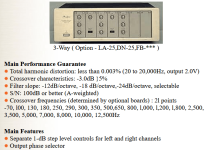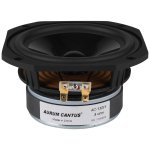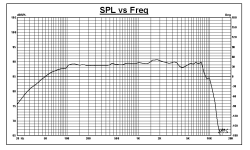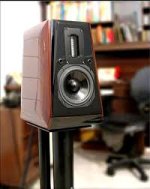Hi everyone.
I was lucky to score a nice external crossover from Accuphase with fixed crossover frequencies. The crossover is equipped with modules to feed a a 4-way design. 3 frequencies modules and 4 line preamp modules. I have 4 stereo outputs.
The frequencies are 130, 350 and 5000Hz.
I am struggling to understand the configuration of drivers for such frequencies. I am not sure if I am willing to build a 4 ways speakers as I just finished a 3 ways speakers with digital crossover using minidsp. But I am curious.
Does everyone have an idea of a typical design with those frequencies? Typical driver size and configuration. Any compatible speakers where I could bypass the internal crossover and feed directly the drivers?
I asked the previous owner. No response yet.
Thanks!
I was lucky to score a nice external crossover from Accuphase with fixed crossover frequencies. The crossover is equipped with modules to feed a a 4-way design. 3 frequencies modules and 4 line preamp modules. I have 4 stereo outputs.
The frequencies are 130, 350 and 5000Hz.
I am struggling to understand the configuration of drivers for such frequencies. I am not sure if I am willing to build a 4 ways speakers as I just finished a 3 ways speakers with digital crossover using minidsp. But I am curious.
Does everyone have an idea of a typical design with those frequencies? Typical driver size and configuration. Any compatible speakers where I could bypass the internal crossover and feed directly the drivers?
I asked the previous owner. No response yet.
Thanks!
Why don't you begin by thinking about which tweeter you'd think best to handle the top end, regardless of how low it can go, and vice versa for the woofer. See where that leads you. A 4 way has plenty of versatility.
You will not get any response from the owner or the manufacturer except the statement "it's for the speaker xy from 198x" without any further comment. It's either made for a single specific speaker or it's made for absolutely perfectly perfoming speakers in their xo range. Try to get a service manual and then calculate the xo slopes and levels. Or measure it. Then you have an idea where to change the values of the CR filters. Without changing the filter properties and levels, the crossover is of absolutely no usable value. A big name on it doesn't make it any better for actual use. The big name does not provide you of any benefits over your DSP unless you are changing every filter to exactly what you are doing in the DSP. And I can tell you, it's definitely not worth the effort. Either (re-)build the original speaker for it or sell it.
Fixed 130/350/5000 Hz sounds very odd to me... No wonder you got it obviously cheap. Brand Accuhase hints towards hifi, not PA use. XO order is propably 4nd order in signal.
https://www.accuphase.com/history.html
perhaps this one https://www.accuphase.com/cat/f-15en.pdf came with customer selectable xo board modules.
No dsp with eq or delay settings, just gain potentiometers.
0 to 130Hz is subwoofer territory and it is nice to play it in stereo - better mode distribution and stereo imaging of transients (drum kicks).
130 to 350 is actually very easy task for any 15-6,5" woofer.
350-5000Hz is challenging... a 4-5" fullrange cone or dome mid to bullet or 19mm dome tweeter? Directivity problems...
If you find a CB-2500 or CB-3500 board, speaker design is much easier.
p.s. Attention multiway horn speaker fans! https://horns-diy.pl/

https://www.accuphase.com/history.html
perhaps this one https://www.accuphase.com/cat/f-15en.pdf came with customer selectable xo board modules.
No dsp with eq or delay settings, just gain potentiometers.
0 to 130Hz is subwoofer territory and it is nice to play it in stereo - better mode distribution and stereo imaging of transients (drum kicks).
130 to 350 is actually very easy task for any 15-6,5" woofer.
350-5000Hz is challenging... a 4-5" fullrange cone or dome mid to bullet or 19mm dome tweeter? Directivity problems...
If you find a CB-2500 or CB-3500 board, speaker design is much easier.
p.s. Attention multiway horn speaker fans! https://horns-diy.pl/
Last edited:
Hi Juhazi, it is an Accuphase F25. Finding a FB-2500 (frequency board) or FB-3500 is almost impossible. Maybe I can try to replace the components on my FB-5000 to get to 3000 Hz. Indeed, 350 to 5000Hz is challenging. I was just curious if someone else had a better idea on how it was used. I agree on the odd frequencies.
Thanks for the reply and support.
Thanks for the reply and support.
That's a crazy piece of hardware! Maybe the original owner used the 350/5000 crossover points to replace the factory crossover of his speakers and the 150hz to cross over to a sub? Odd choices for sure. Looks to me like you can run it in 3 way and just not use the 150hz.
You can do 350- 5khz - just use a full range driver plus a tweeter with a waveguide to reduce directivity mismatch of the high crossover.
You can do 350- 5khz - just use a full range driver plus a tweeter with a waveguide to reduce directivity mismatch of the high crossover.
50 years ago tweeters weren't as capable as modern tweeters and required higher crossover frequencies like 5 kHz. Amplifiers had significantly less power requiring drivers to be more efficient than modern one. This lead to the widespread use of large lightly damped cones to cover wide frequency bandwidths. These resonated significantly over the passband but with careful design they could have a fairly smooth response. At higher frequencies with the inner part of the cone largely following the movement of the voice coil and the outer part moving relatively little they mimiced to some extent smaller driver. There are few drivers like this around these days in home audio. The long established retro companies like Spendor and Harbeth still have one or two drivers that lean towards this way of working but even they are moving to higher performance modern designs. The modern retro designs like Mission, Wharfedale, etc... are only retro in looks and not function. PA drivers tend to function like this but heavily weight efficiency to get high output at the expense of controlling resonant behaviour.
Your crossovers don't look suitable for high fidelity speakers by modern standards but might have a role in a modest cost fun speaker. Personally I rather like the characteristic sound of old large wideband 8-10" midwoofers.
Your crossovers don't look suitable for high fidelity speakers by modern standards but might have a role in a modest cost fun speaker. Personally I rather like the characteristic sound of old large wideband 8-10" midwoofers.
If I had crossover with 350-5k points, I would use aurum cantus ac130f1 mid with some nice ribbon on top. Below 350Hz i would use good 10-12" woofer. Just a suggestion from the time i played with 3way crossover. 4way is just one extra 15" below 130Hz 🙂
Seems all doable to me.
Seems all doable to me.
Attachments
Something like a woven carbon fiber or glass fiber, or doped paper or poly 4" would be a good spot from 350 to 5k, something with minimal breakup. The right prosound 4" or 5" might even work. 150 to 350 I would look at prosound 10 or 8 inchers, as they can be dynamic and don't need or have the extension and do great midbass. Maybe the B&C 8P21 or similar. And a solid 12 or 15" for the bottom to match.
A few threads that might be of interest - my recollection is they don't give answers to everything, but they do give some details and potential people to try to contact.Maybe I can try to replace the components on my FB-5000
https://www.diyaudio.com/community/threads/accuphase-f-25-active-crossover-board-mod-help.279073/
https://www.diyaudio.com/community/threads/accuphase-f-25-crossover-boards-for-sale.384427/
https://www.diyaudio.com/community/threads/accuphase-xover-250hz-values.406215/
Hi everyone. Thank you so much for all your inputs and support. It was not my goal (more curiosity) to build a 4-way speakers based uniquely on the current crossover points of the Accuphase. Based on what I could read, seems even more pain than gain.
Thanks to the different links attached previously, I was able to reserve engineer the values of the resistors and capacitors of the crossover cards. I will most probably try soon to remove the resistors and capacitors and replace with new values. I have a current 3-ways DIY with 380Hz and 3000Hz crossover points using a minidsp nanodigi. Will try to use the active analog crossover replacing the nanodigi. Not sure it will be much better or worse but always wanted to try a full analog crossover. Seems I have now a good excuse to make it happen. Will use the DSP in my current streamer (Wiim Ultra) to fine tune the frequency response.
Thanks again!
Thanks to the different links attached previously, I was able to reserve engineer the values of the resistors and capacitors of the crossover cards. I will most probably try soon to remove the resistors and capacitors and replace with new values. I have a current 3-ways DIY with 380Hz and 3000Hz crossover points using a minidsp nanodigi. Will try to use the active analog crossover replacing the nanodigi. Not sure it will be much better or worse but always wanted to try a full analog crossover. Seems I have now a good excuse to make it happen. Will use the DSP in my current streamer (Wiim Ultra) to fine tune the frequency response.
Thanks again!
If the upper-bass card filtered one-sided i.e. low-pass not band-pass, would work very well indeed as 3.5-way.
130 down 12" sub
130 to 350 8" mid bass
350 to 5000 2" dome mid
5000 up 3/4 " dome tweeter
So with directionality of tweeters.
Larger sizes can cross over lower say 2000 or 3000
Only trade-off , very generalized is larger dome to go
lower in frequency.
So directionality will drop off sooner because of larger
surface.
Smaller tweeters only 3/4 inch have much better
off axis. Trade off. Being small usually 4000 to 5000
is a more ideal crossover for no distortion.
So when you say 5000 Hz crossover very small
tweeter is a joy to use. Problem is the midrange
driver has to be small enough to not have directionality
up to 5000
350 to 5000
Would be 3" to 2.5" driver
and even wide band no larger than 4"
3" to 3.3 inch more preferred.
Trade- off here is low sensitivity for small
direct radiators. maybe 82 to 85 dB
exceptions, but large average wont go
much above.
So for a smaller mid to be able to cross
high at 5000 to tweet.
Be a dome midrange. Which can be higher
from 88 to even 92 dB
The real magic being tight tight mounting
very little center to center spacing.
Is a rather untouchable system.
Small dome midrange, Small dome tweeter.
Allows them to be mounted very very close.
And rather excellent off axis abilities.
Not many seem to know Accuphase or many
4 ways?
Most the high end systems were dome mids
and dome tweeters.
Rather expensive drivers in the 80's and 90's.
130 to 350 8" mid bass
350 to 5000 2" dome mid
5000 up 3/4 " dome tweeter
So with directionality of tweeters.
Larger sizes can cross over lower say 2000 or 3000
Only trade-off , very generalized is larger dome to go
lower in frequency.
So directionality will drop off sooner because of larger
surface.
Smaller tweeters only 3/4 inch have much better
off axis. Trade off. Being small usually 4000 to 5000
is a more ideal crossover for no distortion.
So when you say 5000 Hz crossover very small
tweeter is a joy to use. Problem is the midrange
driver has to be small enough to not have directionality
up to 5000
350 to 5000
Would be 3" to 2.5" driver
and even wide band no larger than 4"
3" to 3.3 inch more preferred.
Trade- off here is low sensitivity for small
direct radiators. maybe 82 to 85 dB
exceptions, but large average wont go
much above.
So for a smaller mid to be able to cross
high at 5000 to tweet.
Be a dome midrange. Which can be higher
from 88 to even 92 dB
The real magic being tight tight mounting
very little center to center spacing.
Is a rather untouchable system.
Small dome midrange, Small dome tweeter.
Allows them to be mounted very very close.
And rather excellent off axis abilities.
Not many seem to know Accuphase or many
4 ways?
Most the high end systems were dome mids
and dome tweeters.
Rather expensive drivers in the 80's and 90's.
I would be happy to trade/swap my unused cards to your FB-130 and FB-5000. I have the following unused cards: FB-50, FB-70, FB-650, FB-800, FB-1200, FB-7000 & FB-8000
Please let me know. Thanks
Please let me know. Thanks
- Home
- Loudspeakers
- Multi-Way
- Reverse Engineering 4-way Speakers



